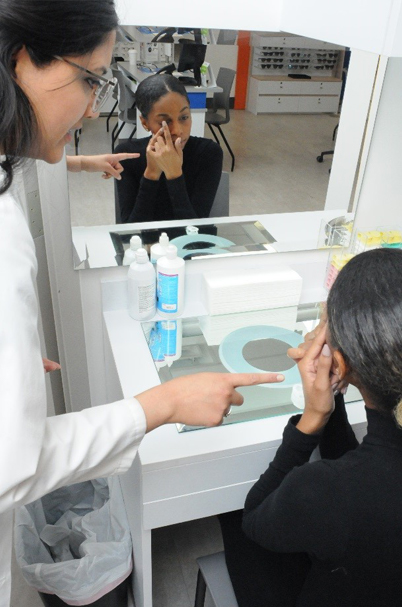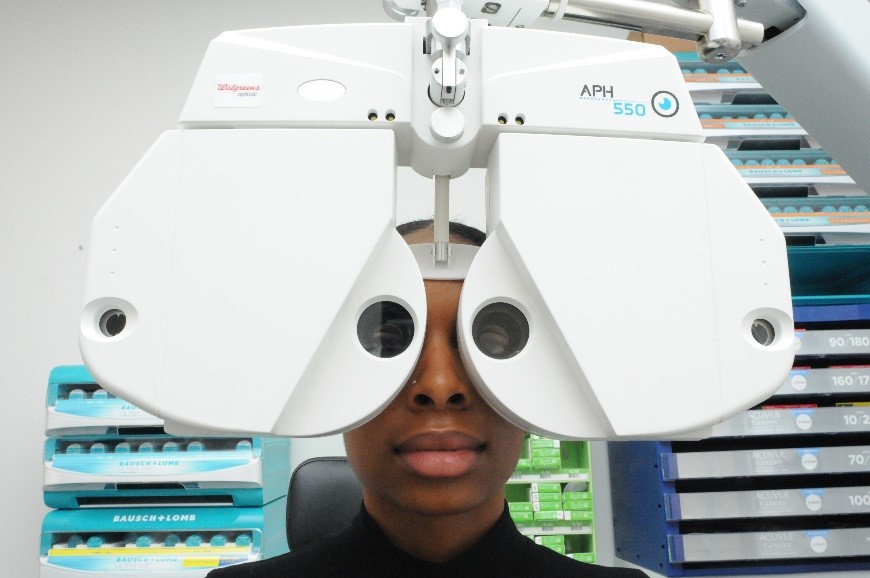Janaki Patel, doctor of optometry at For Eyes at Walgreens in downtown Chicago, conducts an eye exam.
You can come to Walgreens to fill your prescriptions – nothing you didn’t already know there – but these days, convenient health care doesn’t end at our pharmacy counters. In fact, there’s a growing portfolio of additional health care services now available at select Walgreens around the U.S. – everything from primary and immediate care from doctors and nurse practitioners to diagnostics (lab work), weight-loss management and even hearing services. We’re watching how these services resonate with our customers, and evaluating them to see how we might expand them – all while working together with other health care companies and providers who share our vision.
Wait, vision?
Yep, Walgreens also has 10 optical centers in the Chicago area – three in the city, seven more in the suburbs – which recently were rebranded as For Eyes at Walgreens in collaboration with For Eyes, an optical provider with more than 100 locations in 11 U.S. states and Puerto Rico. For Eyes at Walgreens offers comprehensive eye exams and a full range of optical services, as well as an expanded assortment of name-brand frames and lenses. It also accepts most vision insurance plans.
Janaki Patel is the chief doctor of optometry at the For Eyes at Walgreens on Chicago’s Magnificent Mile – the first of the 10 optical centers to open in December 2016. Before coming to Walgreens, she spent her early professional career exploring ocular disease at the University of Illinois-Chicago, and also worked at a private optical practice. Walgreens News caught up with her for some everyday eye advice, as well as her thoughts on what sets For Eyes at Walgreens apart for patients.
Walgreens News: March is “Save Your Vision Month.” Let’s say I only go in to get my eyes checked every few years, to update my prescription. What else should I be doing to take care of my eyesight that I’m maybe not thinking about?
Janaki Patel: The first rule is to always use UV protection. Sunblock, sunscreen – most people know how important those are for the rest of your body. But people aren’t always as mindful of protecting their eyes from ultraviolet light as well. Using UV protection when you’re outside helps protect your eyes from developing cataracts, macular degeneration and other ocular diseases down the road. You can wear sunglasses with or without a prescription. You can also get photochromic lenses that change from light to dark when you go from inside to outside. You can even get contact lenses that have a UV filter built into them.
 WN: After UV protection, what else can be done?
WN: After UV protection, what else can be done?JP: I recommend that everyone follow the “20-20-20 rule.” After every 20 minutes of “near” work, look at something at least 20 feet away for 20 seconds. This helps reset your eye muscles. Many people, including myself, spend a lot of time on computers, cell phones and other digital devices – anywhere from an hour a day to all day. And we end up with a lot of digital eye strain, dry eyes and other long-term symptoms that can improve by giving our eyes a little bit of a break. When you’re on a digital device or computer, your blink rate often decreases and your eyes dry out more. Using artificial tears and having a blue light filter in your glasses may also help.
My next piece of advice is to eat a healthy diet with antioxidants – important not only for the eyes, but for the whole body as well. Green, leafy vegetables like spinach and kale, brightly colored vegetables like bell peppers and carrots, and omega-3 fatty acids found in salmon and walnuts are key to keeping your eye structures healthy, and to help prevent other underlying conditions like cardiovascular disease, which can in turn result in additional eye disease.
WN: So there’s truth to our parents and grandparents telling us carrots help our eyesight. It’s not just an old wives’ tale.
JP: [laughs] Carrots are definitely part of it, but you don’t want to only eat carrots every day. You want a variety of different foods and antioxidants for the best benefit.
WN: Does diet have any regenerative effects on the eyes, or is it all preventive to avoid problems later?
JP: Even after you’ve been diagnosed with some type of disease process, a healthy diet may help you manage that better, and possibly even see improvement. It’s most important to start eating healthy before conditions develop – but it’s also never too late to make a change.
Which leads into the next tip, and this is another big one. Don’t smoke! If you’re a smoker, try to stop – again, this is important not just for the eyes, but also for the rest of the body. Smoking has been linked to eye disease like macular degeneration. There is a genetic component we can’t really control yet, but we do have control over smoking and maintaining a healthy diet.
And here’s my last tip, which you really need to follow specifically, since you said it’s been a few years since your last exam …
WN: Uh-oh …

JP: Make sure to have an annual eye exam, even if you feel like you see everything you need to in your day-to-day life. It’s important because we can sometimes detect underlying health conditions like diabetes and high blood pressure just from an annual exam. When we dilate the eyes, we’re looking into the back of the eye at the retina tissue and blood vessels. The eye is the only place in the body where you can non-invasively look directly at these blood vessels and see early changes to detect ocular disease or systemic disease. A patient might come in initially thinking they’re just getting their glasses updated, but we can actually set them on a path to see their primary care doctor to evaluate something like high blood pressure or diabetes and start treatment, if needed.
WN: You came from a private practice. What it’s like now providing optical services inside a well-known retail pharmacy chain like Walgreens? How is the experience different for you and for patients?
JP: This is really a unique practice model. Working at Walgreens, I can build networking opportunities and relationships with some major companies and use resources I might not have had access to with a smaller clinic. Also, having over-the-counter products literally right outside our optical center has been so convenient. I can walk with my patient to the aisle and point to exactly what product I want them to use, instead of writing it on a piece of paper and hoping and praying they pick out what I have recommended. [laughs] Same thing with the pharmacy. I can literally walk right next door to see the pharmacist and discuss insurance coverage, availability of prescription products and more, instead of going back and forth on the phone. Because we’re located under the Walgreens roof, we’re usually connected with nurse practitioners, pharmacists and other health care partners – even audiology and lab work – so we can all better co-manage patients together. We get a lot of incoming referrals for urgent eye-related conditions like pink eye and styes. When we see patients with those conditions, we can immediately send any prescriptions to the pharmacy of the patient’s choice, which is often inside the same Walgreens, so the patient can have a seamless experience.
Another main factor that really differentiates us at a Walgreens location is that we have digital equipment – advanced instruments and a digital refraction system that is extremely accurate. Patients have a great experience, and we’re very medically oriented.
One great benefit that For Eyes has brought for us is their large selection of frames, including designer frames we have not had in the past like Ray-Ban, Oakley, Kate Spade and so many others. That has really helped our patients by giving them a greater variety of choices for the best fit. There are a lot of positives from both companies – from Walgreens and from For Eyes – and being able to take the best of both and create a hybrid model here has been really exciting.
